The capital of the Alpine region of South Tyrol with a Mediterranean character; a meeting place of cultures and a modern economic centre with a lively tradition as well as the cultivation area of South Tyrol's most important red wines - Lagrein and Vernatsch - that is Bolzano. The districts of Gries (Lagrein) and the St. Magdalener hill (Vernatsch) are something like Grand Crus for these two varieties. The dark-coloured, strong Lagrein had gained great reputation in the last 20 years with highly decorated premium wines. Vernatsch, i.e. Classical St. Magdalener, has only recently come to its deserved recognition, which is - certainly not only - but largely due to the 'stubbornness' and sense of tradition of the self-marketers on and around the Magdalener hill. It is to them, therefore, that the first part of this report on Bolzano's wineries is dedicated.
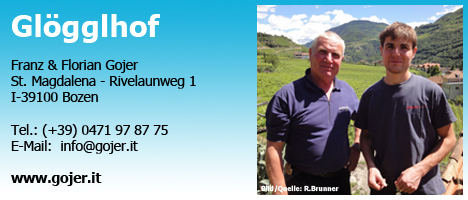
It is the spring of 1986 and there is great excitement in the South Tyrolean wine world - in the truest sense of the word: people are getting upset. They are upset about the wine magazine VINUM, which dedicated its cover story to the wine country of South Tyrol and tasted its wines in detail. VINUM's verdict was scathing - and: VINUM was right! Today's wine paradise presented itself at that time on a very modest level - with very few exceptions. One of them was Franz Gojer, whose Lagrein and St. Magdalener wines gave the VINUM tasters hope that South Tyrol could produce something other than thin Vernatsch in large quantities. Fortunately, a lot has changed in South Tyrol. Franz Gojer has not. He has remained the same and his wines - though no longer lonely - continue to top the South Tyrolean classics Vernatsch and Lagrein every year. And because the word "competitor" does not exist in Franz Gojer's vocabulary, he himself is one of the most pleased about the general increase in quality and the associated success of his colleagues.
Since 2009, his son Florian has fully joined the business and the range has been expanded by three white wines and a 'port'. In addition, the vineyards were increasingly converted to near-natural cultivation. The white wines - Pinot Blanc, Kerner and Sauvignon - grow on a vineyard acquired in 2008 in Karneid at an altitude of 600 metres with high temperature differences between day and night. This produces clear, pleasantly spicy wines with fine, elegant acidity - true mountain wines. The white wine vines were newly planted there, but despite their young age, the wines already present themselves at a very high level (see here). The Vernatsch vines, which were not optimally planted in these high locations, had to give way - except for the plants in the best positions, from which the Gojers press the Vernatsch 'Alte Reben'. For me, this wine with its fresh, pithy, slightly taut character is one of the most interesting Vernatsch wines I know. And with an ex-farm price of around 7 euros, it's almost free.
The Gojers' 'port' is a Lagrein that is fortified with alcohol like the original from Portugal. To get the characterising, distinctive cherry fruit of the Lagrein into the final product, the Gojers often have to sacrifice a few hours of sleep. This is because these aromas are only formed for a very short time in the Lagrein fermentation process. It is precisely during this time that the fermentation must be stopped by spraying - no matter what time of day or night. The end product regularly compensates Franz and Florian Gojer for the lost sleep. It is a dense, intense wine with a fine, cherry-fruity sweetness. It was named after the 'pipas', the typical oak barrels in which port wine is stored in Portugal. A unique wine in South Tyrol and one of the few wines that go really well with chocolate desserts. The traditional winery 'Glögglhof', where for a long time only the classic South Tyrolean varieties set the tone, is therefore also an excellent address for unusual innovations.
The Glögglhof wines in the Wein-Plus wine guide
Prices range from 7 to 16 euros. The 'PIPA' costs 25 euros/0.50 litres. Visitors are always welcome by appointment.
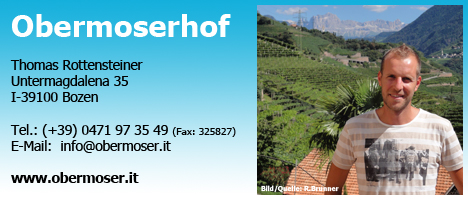
"We have just received Merum 5/2003. The Selezione commentary 'Kalterer and Magdalener: sometimes Burgundian...' warmed my heart. The high praise for our farm and the Fliederhof, as well as the good results of other local independent winegrowers, give me courage and joy...I would like to thank you in any case for the very motivating comment. Also on behalf of my father and brother, whose eyes 'sparkled' when I just congratulated them on the successful St. Magdalener 2002." (Letter to the editor by Christian Rottensteiner in Merum 06/2003). This letter to the editor expresses what the Obermoserhof winery is all about: joy over the qualities of the wines grown on the St. Magdalener hill. Regardless of whether the wine rated best in the tasting comes from their own farm or from a neighbour, and enthusiasm for their own work. Shortly after the Merum article appeared, I visited the Obermoserhof winery for the first time and have since enjoyed the 'sparkle' in the eyes and the associated enthusiasm of Heinrich and Thomas Rottensteiner anew every time I visit. Combined with the seriousness and objectivity that both of them display, they are my guarantee that the best that the respective vintage has to offer is always bottled here.
The Obermoserhof was first mentioned in a document in 1630. It has been owned by the Rottensteiner family since 1890. It has always been finished wine, never grapes. Mainly to Switzerland and Austria. Until the beginning of the 1980s, the wine was sold in large containers, then only as bottled wine. The Obermoserhof is thus one of the pioneers in bottled wine sales on the St. Magdalener hill.
The main focus is on the classic St. Magdalener, or Vernatsch, where one can fall back on a valuable stock of old vine material from Grauvernatsch, Mittervernatsch and Tschaggelevernatsch. These are now gradually replacing the higher-yielding clones planted in the 60s and 70s, giving the finished wine more intensity. Like some of his colleagues, Thomas Rottensteiner is therefore toying with the idea of pressing a second line, i.e. a kind of St. Magdalener Riserva. "The feat we have to achieve is that this wine must be more complex, more intense and (even) longer-lived, but not heavier than the Classic St. Madgdalener as we know it today. Because heaviness does not suit St. Magdalener," says Thomas Rottensteiner. I am confident in this regard, because the young guard of St. Magdalener winemakers, like their fathers, are also very attached to tradition and would rather do without a wine that is impressive but atypical because it is not smooth and drinkable.
The wines of the Obermoserhof in the Wein-Plus wine guide.
Prices range from 8 to 17 euros. Visitors are always welcome by appointment.
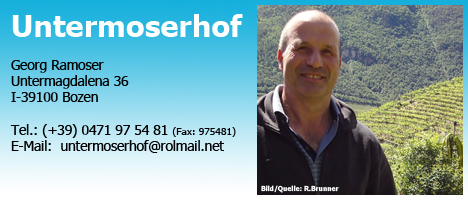
The Untermoserhof, first mentioned in 1630, used to be an inn and is now run by the 4th generation of Georg Ramoser and his wife Margareth. Georg Ramoser would certainly also have made a good innkeeper, because he is a sociable person who almost always wears an honest, open smile on his face and meets every visitor to his winery with sincere friends. All facets of his work as a winegrower - the work in the vineyard, the development of the wines in the cellar and also the sale - obviously give him great pleasure. On the one hand, this is simply due to his character, and on the other hand, it is certainly also due to the fact that he can draw on the full range of his vineyards as far as quality is concerned. Even in the days of open wine sales in the 60s and 70s, when South Tyrolean wine was primarily about the largest possible quantities, there were outstanding wines at Untermoserhof from time to time. "If in certain years, due to the climatic conditions, the vineyards were not as abundant, then the wines were also different. Certainly not worse than today, and when I open a bottle from that time now and then after a good 25 to 30 years, I ask myself whether they weren't sometimes even better wines back then, even if they came about involuntarily. In any case, they show what is possible in our vineyards in terms of quality - and of course also what storage qualities our wines can have. This is often underestimated with Magdalener, because it is (still) communicated as a wine to be drunk young. As a wine that lives above all from its freshness. Freshness is certainly a characteristic of its youth, but that is not all that the Verntasch wines have to offer here in St. Magdalena," says Georg Ramoser. The Magdalener - winegrowers always meet on New Year's Eve for a tasting of their mature wines "and there it becomes apparent - even if not with every bottle - that Vernatsch is often underestimated as far as its development potential is concerned." You can't buy mature wines from Georg Ramoser. You have to be lucky or quick to get hold of the current vintages, because he is usually sold out long before the next vintage comes up for sale. In addition to the classic St. Magdalener, Georg Ramoser also produces Lagrein as a vintage wine and as a Riserva, a Merlot and a white wine made from 100% Chardonnay.
Prices range from 9 to 17 euros. Visitors are always welcome by appointment.
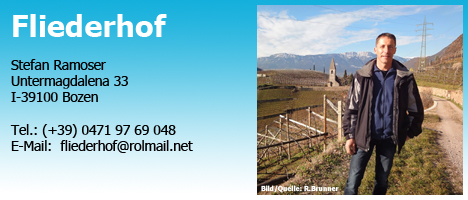
A friend of mine 'discovered' the Fliederhof at the beginning of the millennium, after the St. Magdalener of this winery had taken one of the top places in a tasting of the magazine Merum. Since then, the Fliederhof-Magdalener has sometimes taken top, sometimes middle places in the Merum tastings as well as in other tastings. My friend is no longer too interested. Since then, he always buys his Magdalener and also his Lagrein from Fliederhof, because - according to my friend - "I can always drink these wines on any occasion. Whether it's a fine meal, a hearty snack, an interesting conversation or even a convivial round of cartels, because the wines are of high quality and at the same time pleasantly uncomplicated." This starts with the local white wine speciality Goldmuskateller, which is a fine aperitif wine when dry, and continues with the Klassischer St. Magdalener, which - see above - is one of the finest of its kind in some years, as well as with the Lagrein, which presents itself in an extremely animating way both in the fresh basic version and as a Riserva. As one of the few producers of the dry Gold Muscat, Stefan and Astrid Ramoser are particularly proud of this wine, which they still call 'Pfefferer' internally. This used to be on the label until a large winery claimed this name exclusively for itself. In the meantime, the wine was called 'Pfeffferer' until this was also forbidden and it was now renamed 'Peperum'. The wine has always retained its animating, unconventional 'peppery' character.
The Fliederhof wines in the Wein-Plus wine guide
Prices range from 9 euros to 17.50 euros. Visitors are always welcome by appointment.
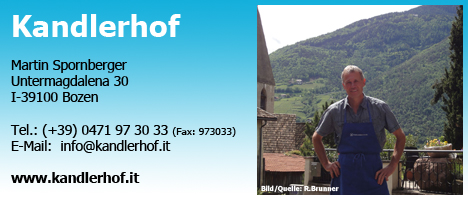
The Kandlerhof was first mentioned in a document as a farmstead in 1275, at that time still under the name Dornerhof, because of the many blackberry bushes that still surround the property today. In 1777, the farm came into the possession of a pewterer who also produced pots and gave the farm its present name. The Spornberger family took over the farm in 1793. The greatest achievement during this time was certainly Martin Spornberger's father, Gregor Spornberger, when, as an eight-year-old boy, he initially continued to manage the farm together with his uncle after his father's early death, and then, at the age of 14, took it over completely on his own. With a lot of work by the whole family, but above all with a lot of entrepreneurial courage and Gregor Spornberger's open-mindedness towards new things, the family managed not only to keep the Kandlerhof afloat during these difficult times, but also to make it what it is today: an exemplary family winery in a prime location on the Magdalener hill, which has a lot to offer not only wine connoisseurs but also other visitors to South Tyrol (since 1978 rooms have also been rented here). Wine connoisseurs particularly appreciate the Kandlerhof's Klassischer Sankt Magdalener, a smooth, fine representative of its kind. Martin Spornberger and his son Hannes, who has been responsible for production for several years, attach great importance to this characteristic. Not only with the classic Sankt Magdalener, but also with the dark, powerful Lagrein, which he therefore no longer makes as a Riserva, but only as a vintage wine. The fact that these wines can be drunk young does not necessarily mean that they have to be drunk young. Both can mature for a good four to six years. In the case of the white wine, Sauvignon Blanc, the Spornbergers have found their style after some initial searching and produce a fine, fruity Sauvignon in which freshness and fullness form a good balance.
The Kandlerhof wines in the Wein-Plus wine guide
Prices range from 8 euros to 10.50 euros. Visitors are always welcome by appointment. Five double rooms and one multi-bed room are available for guests.
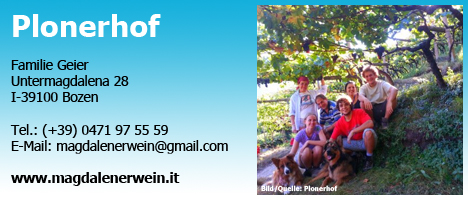
The Plonerhof is located directly opposite the Kandlerhof next to the church on the Magdalener hill. Despite this exposed location, it seems rather hidden. Apart from an inconspicuous wooden sign, there is little to indicate the winery. Also with regard to the presence of the wines at presentations, fairs, etc., the winery has so far remained rather in the background. Winegrowing has always been practised here, but rather as a sideline. This will certainly change soon, because Simon Geier has recently taken over responsibility for the wines. He learned viticulture at the Happacherhof viticulture school and his first bottlings show that he has mastered his craft (see here). With increasing experience, the wines will certainly improve in quality. After all, the St. Magdalener Classico 2014 from Plonerhof was named South Tyrolean "Vernatsch of the Year 2014" by Dolomiten-Verlag! One guarantee for continued positive development at Plonerhof is the drive with which Simon Geier approaches the matter. He wants to produce classic wines, which is why he restricts himself to the typical varieties of the Magdalener hill: classic St. Magdalener, Lagrein, which here is called 'Lagarena' to emphasise its origins in St. Magdalena, and the dry, slightly aromatic white wine speciality Goldmuskateller.
The Plonerhof wines in the Wein-Plus wine guide
Prices range from 7 to 14 euros. Visitors are always welcome by appointment.
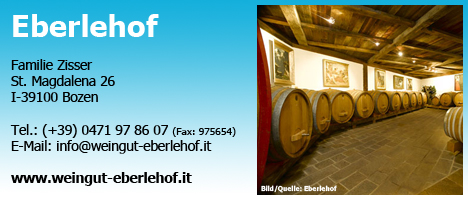
The Eberlehof is situated in a prime location at the top of the Magdalener hill. It was first mentioned historically as a wine farm in 1312. Since 1668, the traditional farm has been owned by the family. The classic wines of the Magdalener hill - St. Magdalener and Lagrein - are produced here, as well as single-vineyard Cabernet and Merlot and a red wine cuvée of Lagrein, Cabernet and Merlot. As a special treat, there is also the rare Blaterle, a dry, light white wine that is typical of the Bolzano region but does not have DOC status and is therefore sold as a table wine. A pithy - fresh grappa is distilled from the marc of the classic St. Magdalener. The vineyards, some of which are old and planted with mixed vines, are cultivated in a natural way.
Entering the cellar building reveals another special feature of the Eberlehof: High-quality works of art in a variety of styles characterise the ambience. Besides wine, art is Tomas Zisser's great passion. The paintings and sculptures exhibited here are of high quality and are much sought after as loans at exhibitions. And it is not only the eye that gets something here. Concerts with classical music also take place at the Eberlehof. It is important to the Zisser family that the wine is embedded in a harmonious overall ambience.
Prices range from 7 to 12 euros.
Visitors are welcome at any time after booking by telephone. Two spacious holiday flats are available for guests.
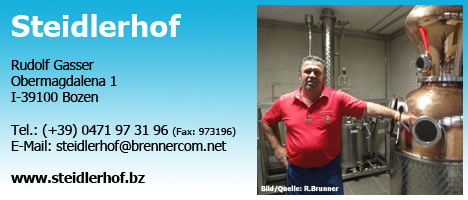
Rudolf Gasser likes to work a lot. That is also important, because on a winery, even if it is very small, there is always a lot to do, especially when not only wine is produced, but fruit is also cultivated and schnapps is distilled. So Rudolf Gasser doesn't shy away from work, but he loves to do it in a quiet, relaxed way and above all free from sales pressure. That is why he has decided not to increase his wine production despite the available opportunities. More than 6 to 7,000 bottles a year are never produced here and you can't buy the wines from merchants, but exclusively from the farm. In 2005 Rudolf Gasser and his wife Claudia decided to revive the tradition of the Buschenschank and stylishly renovated and extended the historic buildings. The new Buschenschank extends over the former stables to the courtyard with a large, inviting glass front offering a magnificent distant view of the mountains - an ideal place to get to know the house's own growths over a merende (snack) or another typical South Tyrolean dish. A white wine (Sauvignon Blanc), four reds (Vernatsch, St. Magdalener, Lagrein and Cabernet) and the South Tyrolean dessert wine speciality Rosenmuskateller are produced. All of them are fine, typical wines that invite you to sit down and enjoy them with a wonderful view of the Magdalener hill. Recently, you can also enjoy the last essence of Steidlerhof wines: single-varietal grappas made from their own marcs.
At present, the wines are not yet bottled, but only served in the Buschenschank.
A visit is uncomplicated during the opening hours of the Buschenschank in spring and autumn (mid-March to early June, Thurs-Sun: 11-24 hrs and mid-September to early December, Wed and Thurs: 17-24 hrs, Fri-Sun: 12-24 hrs). Otherwise, visitors are welcome at any time by appointment.
Two spacious holiday flats are available for guests.
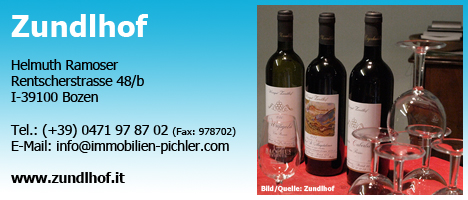
Helmuth Ramoser's great passion is flying. He likes to climb into one of his three self-built ultra-light aircraft, take off and see the world from above. When it comes to wines, on the other hand, he likes to keep it down to earth. This means that good, classic South Tyrolean wines with controlled designation of origin D.O.C. are produced at Zundlhof: St. Magdalener Classico, Lagrein, Pinot Noir, Pinot Blanc, Cabernet Sauvignon and Merlot. There is no big fuss about the wines. Long, profound discussions about wine are not Helmuth Ramoser's thing. For him, wine is first and foremost a tasty and therefore life-enriching drink. Typicality is a matter of course for him, even if some of his growths have strange names like 'Caberlein' and 'Weißgold'. Both are wines made from classic South Tyrolean varieties. The former is a cuvée of Cabernet and Lagrein, the latter is made from Pinot Blanc and Gewürztraminer. He deviates from the usual with these wines, not to draw special attention to them, but because he finds that these cuvées make pleasant, tasty wines. For this, he accepts having to market them as table wines.
In addition to the varieties mentioned, Helmuth Ramoser also produces the "Fliegerwein": a Lagrein rosé that suits Helmuth Ramoser and his passion for flying. On the one hand, it is pithy and direct, at the same time airy and light-hearted and somewhat removed from what is usual.
Prices range from 7 euros to 13 euros. Visitors are always welcome by appointment. Two flats, two double rooms and one triple room are available for guests.
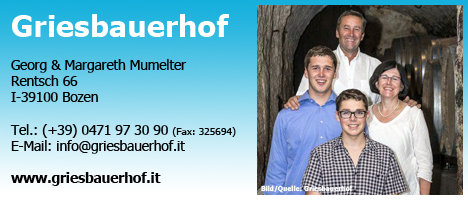
The Griesbauerhof is a time-honoured winery that has been owned by the Mumelter family as a hereditary farm since 1785. However, it has only existed in its current form since the beginning of the millennium when Georg and Margareth Mumelter decided to switch to 100 percent self-marketing. They had a good start right away. Their 1999 Lagrein Riserva was awarded "Three Glasses" by the Gambero Rosso and thus attracted a certain amount of attention from a discerning clientele. Georg and Margareth Mumelter are not aloof because of this. They are down-to-earth winemakers, with a self-confident but also pleasantly reserved character. They have always worked and continue to work with prudence. When the assortment was expanded for a better market presence and innovations took place in the cultivation or maturation of the wines, the sensibility of the respective activity was always in the foreground and not the commercial aspect. The range currently consists of ten wines. In addition to the red wine classics - St. Magdalener, Lagrein and Lagrein Riserva - there are two white wines - Pinot Blanc and Pinot Grigio - which come from slightly higher-lying vineyards in Eppan; as well as a Merlot Rosé and a red Merlot from the Spitz vineyard near Bolzano and a Cabernet Riserva. A particular speciality of the Griesbauerhof is the 'Isarcus', a Vernatsch in which the grapes dry slightly and their ingredients concentrate. Those who fear an over-concentrated, heavy wine can be reassured. In addition to its perceptible dry fruit component, the 'Isarcus' has a fine floral note and a pleasant mineral-cool freshness. This also applies to all the other strong, dark wines of the Mumelters - Lagrein, Cabernet and Merlot.
The wines of the Griesbauerhof in the Wein-Plus Wine Guide
Visitors are welcome at any time by appointment. Prices range from 9 to 18 euros.
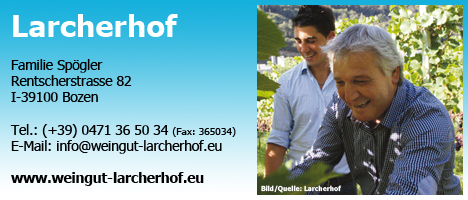
The Larcherhof is a winery with a long tradition. Founded in the 16th century, the farm has been managed by the Egger-Spögler family since 1893. However, self-marketing, i.e. selling the wines produced here under their own label, was discontinued in the meantime. Since 2008, this has changed again. Now the grapes are pressed and bottled into their own wine again. On a total of five hectares of cultivated land, different grape varieties are cultivated in a natural way. In the hot vineyards at the bottom of the valley at the foot of the Magdalener hill, Lagrein and Merlot in particular feel very much at home and produce intense, powerful wines. The Larcherhof's strength lies in its 70-year-old vines, which give the wines their special character. The powerful Lagrein, the Lagrein/Merlot cuvée 'Justinus', but also the rosé made from Lagrein benefit from the intensity and complexity of the grapes from the old vineyards. The Spögler family is particularly proud of the rosé. It is not made from grapes that are too weak for a decent red wine, but from the same grapes that are used for the dark, powerful wines. The result is a full-fruited, intensely spicy rosé, which, due to its consistently dry development, does not appear overloaded at all, but is decidedly drinkable. If you want a rosé to accompany a fine but hearty meal, the 'Kretzer' from Larcherhof is certainly an excellent choice. In addition to the wines mentioned, the Spöglers also produce a Pinot Grigio and a Grauvernatsch. Especially the latter pleasantly surprised me with its fine, cool style.
The Larcherhof wines in the Wein-Plus wine guide
Prices range from 8 to 17 euros. Visitors are always welcome, booking required for guided tastings.
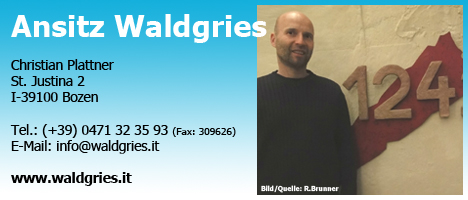
Consisting of thick walls and surrounded by majestic cedars, the Ansitz Waldgries, situated at the foot of Bolzano's local mountain Ritten, exudes something powerful. At the same time, the historic estate blends harmoniously into the surrounding hilly and mountainous landscape. Inside the walls of Ansitz Waldgries, this combination of powerful presence and harmony with the environment is lived out in the daily work of making wine. The quiet Christian Plattner wants to make his mark with distinctive wines. His own style is important to him and he cultivates it accordingly. However, never at the expense of typicality. A prime example of this is his Klassischer St. Magdalener, which is characterised by power, intensity and longevity without sacrificing refinement, elegance and drinkability. This applies to the basic version as well as to the selection 'Anteos', which is made from old Tschaggelevernatsch, Mittervernatsch and Grauvernatsch grapes. The wines with high percentages of these Vernatsch varieties have always been known for their intensity and complexity and were treated like a Riserva. These St. Magdalener wines were probably responsible for putting St. Magdalener on a par with the famous wines of Piedmont in the 1930s.
In addition to his two St. Magdalener versions, Christian Plattner also produces two white wines - Pinot Blanc and Sauvignon Blanc - the dessert wine speciality Rosenmuskateller as well as four Lagrein wines. As with the St. Magdalener, Christian Plattner also sets exclamation marks here in terms of intensity and longevity. Especially with the "Roblinus de' Waldgries", which is only vinified in particularly good years and exclusively from grapes from the top vineyard 'Kirschleiten'. Named after the first owner of Ansitz Walgries, this wine is for Christian Plattner "the best of the good - the essence of Lagrein."
The wines of Ansitz Waldgries in the Wein-Plus wine guide.
Prices range from 9.50 to 28 euros; the Roblinus de' Waldgries costs 65 euros. Visitors are always welcome by appointment.
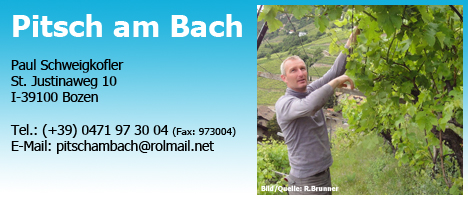
Paul Schweigkofler certainly doesn't do justice to one thing: the first part of his surname. Silence is not his thing. He likes to talk a lot. Unlike many others, however, who like to talk a lot, Paul Schweigkofler also has a lot to say, and he radiates calm, expertise and enthusiasm at the same time when he talks. His farm can look back on a very long history. It was first mentioned in a document in 1350 under the name of the owner at the time, the Florentine banker Boccia. Today, the winery is called Pitsch am Bach and is run as a hereditary farm of the Schweigkofler family. For Paul Schweigkofler, this means that he does not consider himself the owner of his farm "but rather a temporary administrator. As the owner of a hereditary farm, one feels the transience of material things even more intensely, always in view of the ancestors who have come and gone. They have all left their traces, but none of them has been able to take even a grain of sand with them. Thus, I see it as my duty to increase the 'glory and splendour' of the farm through my hands' work and to make the life and work of both the present and future generations as pleasant as possible." The vineyard sites belonging to the farm are characterised above all by their verticality. A tour with Paul Schweigkofler is therefore not only very informative, but above all also very sweaty. But one should not do without it. The steep slopes planted with the autochthonous varieties Vernatsch, Lagrein, Gewürztraminer and the local Bolzano speciality Goldmuskateller, which are cultivated by Paul Schweigkofler in a natural way, are too impressive. "We deliberately chose these varieties, on the one hand because of the optimal sites available for them, but on the other hand especially because of our deeply felt emotional connection with our homeland and our heritage. Hence the clear and straightforward logo on the label" (a wine glass with roots growing out of the stem end) "which represents a triple metaphor: Production of original wines; viticulture from a single source, from the roots of the first young vines to the tasting of the wine in the glass; deeply felt love of the homeland and rootedness in the South Tyrolean self-image." For Paul Schweigkofler, the basic prerequisite for this to succeed is that each variety is grown in the most suitable location for it. And in this respect he goes into great detail. Which clone is the right one at which altitude on which subsoil and with which shoot length - these are the questions he asks himself and during the tour with him you get the impression that he has stored every single vine and its well-being very precisely in his memory. As long and detailed as the walk through the vineyards is, as short and brief is the cellar tour. "In the cellar, the wines ferment and are stored until they are ready for sale. There is not so much for me to say. What the wines don't bring from the vineyard, I can't conjure up in the cellar." In terms of distribution, Paul Schweigkofler had a good start with the Goldmuskateller, a wine formerly called 'Pfefferer'. Like his colleague Stefan Ramoser, he had to come up with a new name for his wine because of the exclusive claim of a large winery to the name Pfefferer. Paul Schweigkofler now calls it 'Pitsch 'n Pfiff'. It is made from old clones and has a very intense, broad spectrum of aromas. The Gewürztraminer is also impressive, with hints of the intense, full-bodied Traminers of the South Tyrolean lowlands.
Prices range from 8 to 12 euros. Visitors are always welcome by appointment.
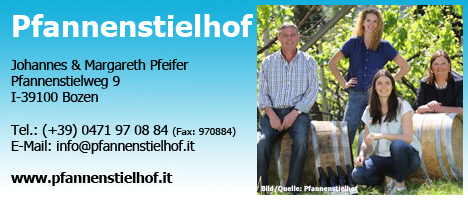
"We celebrate St. Magdalener" - this sentence was emblazoned above a giant grape made of cardboard in the wine cellar of the Pfannenstielhof in autumn 2010 and a good 80 visitors were there for this celebration. They rejoiced with Johannes and Margareth Pfeifer over the long-awaited first award for a Vernatsch wine with the "Three Glasses" from Italy's 'wine bible' Gambero Rosso. It is typical for the St. Magdalener winegrowers that everyone was as happy as if they had been awarded this prize themselves, and it is typical for Johannes and Margareth Pfeifer that they understood this award for their wine as a distinction for the whole growing region. The "Three Glasses" of the Gambero Rosso were not the first award for the Pfeifers' wines. The Pfannenstielhof is now mentioned more and more often when it comes to high-quality Vernatsch, Lagrein or Pinot Noir, and Johannes and Margareth Pfeifer are also very proud of this. But they don't let that put them off their guard. As proud as they are of the many awards, one always gets the impression in conversation with them that they somehow take these awards - without a trace of arrogance - for granted. The Pfeifers have the healthy, relaxed self-confidence of winemakers who know what they can do, combined with the necessary respect and humility for nature, without which all their winemaking skills would be worthless. "We are simply lucky here in the Bolzano soil and on the Magdalener hill to have the best sites for Lagrein and Vernatsch and we have learned to make something out of them," says Johannes Pfeifer. In addition to these sites directly at the estate, the Pfeifers also own a parcel in Planitzing near Kaltern. An excellent Pinot Noir site at an altitude of 500 metres. The Pfannenstielhof is therefore - unusually for today and contrary to the current trend - a pure red wine farm. But the Pfeifers are not interested in the trend, and they don't have to be, because their wines are sold out practically every year long before the new vintage is available.
Visitors are always welcome at the Pfannenstielhof. However, it is not so easy to find, because it is hidden (all the more beautiful for that) behind a railway line that separates it from the city and some sat navs have a hard time with the official address "Bozen, Pfannenstielweg 9". In this case, the Pfeifers recommend entering "Mitterweg, Bozner Boden" and then following the signs.
The wines of the Pfannenstielhof in the Wein-Plus wine guide.
Prices range from 9.50 to 19.50 euros.

Bernhard Pichler's Messnerhof is located in St. Peter on the western side of the Magdalener hill, at the entrance to the Sarntal valley. The geological conditions here are quite different from those in the vineyards in the St. Magdalener district. Instead of predominantly sandy moraine soils, here one finds mainly porphyry as well as primary rock soils consisting of mica schist and gneiss. For the wines, especially for the Vernatsch, i.e. Classical St. Magdalener, this means that they need more ripening due to the higher mineral content of the soils. While the wines of the St. Magdalener vintners are already soft, round and mild in their youth (even the ripe ones), you have to wait a little longer for Bernhard Pichler's Klassischer St. Magdalener. In addition, Bernhard Pichler's vineyards still have many old Vernatsch clones such as Edelschwarze, G'salzne and G'schlafne, which produce low yields and inherently need more time to ripen. Bernhard Pichler cultivates these old varieties and, since they are not available from vine nurseries, has set up a gene bank with Edelreißers on one of his vineyards. This way, he will also be able to draw on these old clones in the future. Up to 8 percent of them find their way into the cuvée of his 'Mos Maiorum'. Mos Maiorum" means "according to the old fathers' custom" and the wine, even if it is not called that, is actually a classic St. Magdalener. However, it is vinified differently than usual. "Burgundy-style", says Bernhard Pichler, with a long maceration period, 15 months of maturation in 500-litre Tonneaux barrels and subsequent one-year bottle maturation. I find the result extremely successful. A typical Vernatsch that does not deny its origin, at the same time demanding, with noticeable - but not repellent - tannin, yet very complex and multi-layered. A Vernatsch wine from the Magdalenerhügel, when the "normal" St. Magdalener gets too cosy. It shows the potential of St. Magdalener and should contribute its share to ensuring that the image of this appellation is no longer (only) characterised by drinkable wine that can be drunk early. In addition to his two St. Magdalener wines (even if one is not called that), Bernhard Pichler also produces two white wines - Terlaner Sauvignon and South Tyrolean Gewürztraminer, whose grapes grow in Missian in the municipality of Eppan, as well as a Riserva Lagrein, whose grapes come from vineyards in Gries, and the cuvée 'Belleus' made from the varieties Cabernet Sauvignon, Petit Verdot, Syrah, Merlot and Tempranillo. Cabernet Sauvignon and Petit Verdot are planted directly at the farm, the last three varieties grow in high locations in Missian.
Special emphasis is placed on environmentally friendly cultivation. Organic farming, natural cover crop and no herbicides have been standard practice at Messnerhof for decades.
Visitors are welcome at any time by appointment. A modern, well-equipped holiday flat with a fantastic view of the Sarntal valley is available for guests.
The Messnerhof wines in the Wein-Plus wine guide
Prices range from 8 to 14 euros.
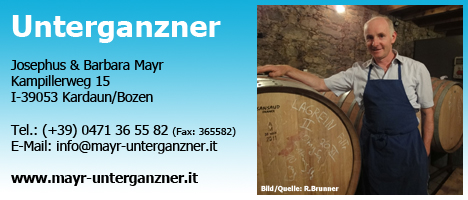
With his wines from Unterganznerhof, Josephus Mayr is one of the smaller producers in South Tyrol. Nevertheless, his name is familiar to almost everyone who deals with South Tyrolean wine - whether professionals or interested laymen. On the one hand, this is due to the wines that stand out from the ordinary and are of high quality, such as the South Tyrolean 'Amarone' Lamarein, the Composition Reif and his Lagrein-Riserva. They are all oenological masterpieces and individual wines in the best sense of the word: powerful growths created with a great deal of sensitivity, which at the same time present themselves as finesse-rich and elegant. The second reason for the great fame and above all the esteem in which Josephus Mayr is held is simply himself, or rather his family, which with the Unterganznerhof runs a winery that is a prime example of traditional and at the same time modern South Tyrol. Here you find strength of character, sensitivity and a healthy sense of what is important, what was important and what will be important in the future: Integrity, honesty, tradition, sustainability and joie de vivre. The latter is also evident, among other things, in the fact that the whole family plays music with dedication and great joy. The tasting of some older vintages of his Composition Reif as part of the Wein-Plus report on mature wines from South Tyrol ("Matured with dignity") showed how sustainable the wines are in the sense of lasting. But sustainability at Josephus Mayr does not only mean that his wines leave a lasting impression and can mature for a long time, but here they also work sustainably in an ecological sense. Erbhof Unterganzner is not a certified organic farm, but what happens here is absolutely exemplary in ecological terms. For Josephus Mayr, this kind of farming is a matter of course. "After all, I am the father of five children and I want to leave them a healthy environment." His son Josef is intensively involved in ecological wine production. Josephus himself is too, but for him it is above all the 'little things' that are otherwise unfortunately often neglected, even on organic farms, such as the weight of the bottles and the way in which energy is generated (the Erbhof Unterganzner produces all its energy from the farm's own hydroelectric power station). In addition, Josephus Mayr is involved in a project with the association 'Tirolensis Ars Vini', which has set itself the goal of producing wines typical of their origin from fungus-resistant varieties and with 100% regenerative energy.
As far as the wines of the Unterganznerhof are concerned, the diversity is constantly increasing. Until a few years ago, the farm was a pure red wine farm, but in recent years, with Sauvignon, Chardonnay and Kerner, some interesting white wines have been added.
The wines of the Unterganznerhof in the Wein-Plus wine guide
Prices range from 8.50 to 35 euros. Visitors are always welcome during opening hours. These are: Mon-Fri: 8.30 a.m. - 12.30 p.m. / 3.30 p.m. - 7 p.m.
Sat: 8.30 - 12.30 hrs. Sundays and public holidays are closed.
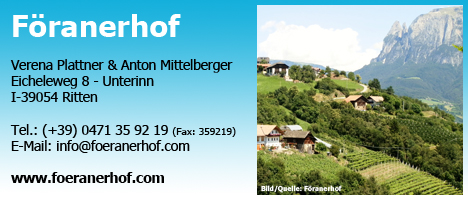
The Föranerhof is situated a little bit away from Bolzano. You have to take a few serpentines up the Ritten, Bolzano's local mountain, and you mustn't let yourself be confused by doubts as to whether wine is still being grown this far up. An altitude of 850 metres is still very high up in terms of viticulture, even in times of climate change. The vineyards of Verena Plattner and Anton Mittelberger are therefore mostly planted with very different varieties than those we are used to in Bolzano and the surrounding area. Apart from Vernatsch, there are none of the wines cultivated in the valley up here. Instead, Müller - Thurgau, Sylvaner and Zweigelt. Varieties that are familiar from the neighbouring Eisack Valley. However, the wines of the Mittelbergers are rather slender, reserved and somewhat meagre, at least not as full-bodied - aromatic as those of their Eisacktal colleagues. On the one hand, this is due to the climatic and soil conditions, and on the other hand, it is certainly also due to the fact that Anton Mittelberger is still fine-tuning his wines. His grapes offer the best prerequisites for interesting wines, which is shown by the fact that these grapes were very much sought after by his former customers, as they could be used to produce exactly the kind of wine that has become increasingly popular recently: fresh, elegant, racy white wines with moderate alcohol content. In 2014, Anton Mittelberger decided to process all his grapes himself and to sell the wines on his own, because he "prefers to work 20 hours a day in his own vineyard, orchard or cellar than eight hours in the factory." The challenge of having to market the entire production themselves is certainly not easy, because the market is now full and the local wine shops are not desperately looking for new products. The Mittelbergers therefore sell their wines mainly in the small shops in the immediate vicinity and at local farmers' markets. Production is not that big at the moment anyway, so sales are a worry and "those who like our wines buy them again and again. Certainly also because they are a bit out of the ordinary." In addition to wine, the Föranerhof sells jams, syrup and soft fruit.
Prices range from 5 to 8 euros
Visitors are welcome at any time by appointment.